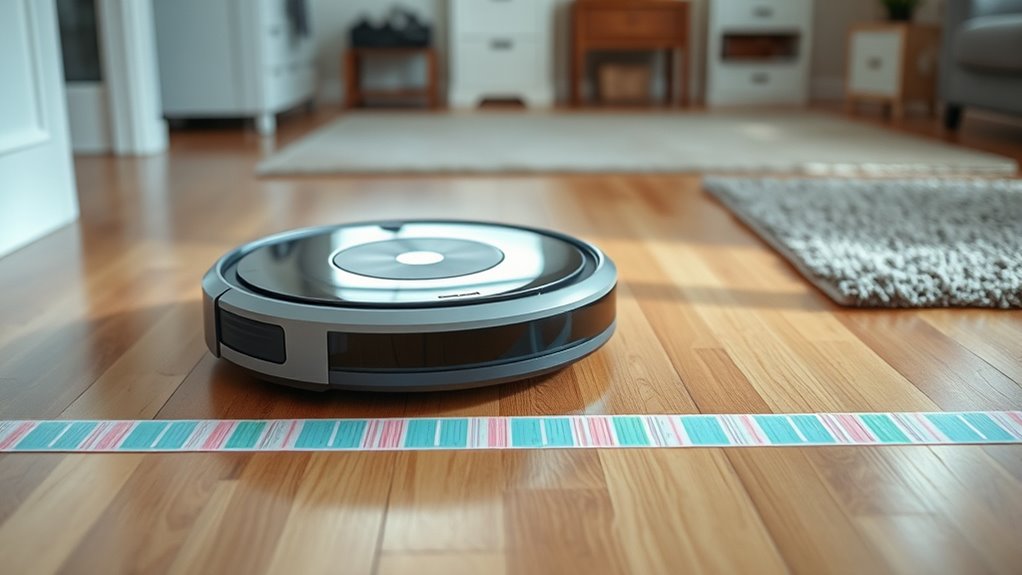To set no-go lines on your robot vacuum, use its app to draw virtual boundaries on the map, which the device will remember and follow during cleaning sessions. These lines prevent the vacuum from entering restricted areas like pet beds, cables, or delicate surfaces. You can adjust these boundaries anytime without physical effort, ensuring your vacuum cleans only where you want. Keep going to discover more tips on customizing no-go zones for better cleaning control.
Key Takeaways
- Use the vacuum’s app or control panel to easily draw and customize virtual no-go lines on your floor map.
- No-go lines prevent the vacuum from entering designated areas like pet zones, fragile surfaces, or under furniture.
- Adjust and reposition boundaries anytime remotely, ensuring flexible and effective zone management.
- Setting no-go lines enhances cleaning efficiency by guiding the vacuum around obstacles and sensitive zones.
- No-go lines help maintain predictable cleaning routines, protecting off-limits areas even when you’re away.

Robot vacuum manufacturers often include no-go lines to help you prevent the device from entering certain areas. These virtual boundaries are essential for managing your cleaning space and ensuring the vacuum doesn’t disturb delicate or off-limits zones. Setting these no-go lines is straightforward and can save you time and frustration. When you draw these boundaries, you’re essentially telling the robot where it shouldn’t go, which helps it avoid obstacles and tricky spots, like pet beds, cables, or fragile decorations. This feature is especially useful if your vacuum uses mapping obstacles to create a detailed layout of your home. With an accurate map, the robot can better navigate around furniture and clutter, making cleaning more efficient. Additionally, no-go lines can help protect delicate surfaces from potential damage caused by the vacuum’s brushes or suction.
Once you’ve established no-go lines, your robot vacuum can stick to the designated areas during its scheduled cleanings. Scheduling cleanings becomes more predictable because the device won’t stray into areas you’ve marked as off-limits. This means you don’t have to worry about the vacuum getting stuck or causing damage, especially in rooms with fragile items or sensitive electronics. It also allows you to set cleaning routines for specific zones, so you can prioritize certain areas at particular times. For instance, you might schedule daily cleaning in your living room but keep the no-go lines active in the kitchen to prevent the vacuum from slipping under cabinets or near open trash bins.
Mapping obstacles and setting no-go lines work together to optimize your vacuum’s performance. As your robot navigates, it updates its map and adheres to the boundaries you’ve established, making future cleanings faster and more accurate. Plus, many models allow you to adjust these no-go lines remotely via an app, giving you real-time control and flexibility. Whether you’re home or away, you can modify boundaries or reschedule cleanings without needing to be physically present. This control helps prevent accidental entry into areas with high foot traffic or pet feeding stations.
Frequently Asked Questions
Can No-Go Lines Be Customized for Specific Rooms?
Yes, no-go lines can be customized for specific rooms through boundary customization. You can set room-specific settings on your robot vacuum’s app, allowing you to draw no-go lines precisely where you want them. This way, you control which areas the vacuum avoids, making cleaning more efficient and tailored to your needs. Boundary customization guarantees your vacuum respects your space without hassle, giving you peace of mind.
How Do No-Go Lines Affect the Robot’s Cleaning Efficiency?
No-go lines can slightly reduce your robot vacuum’s cleaning efficiency since they limit where the device can navigate. However, they help with boundary creation, preventing it from entering areas you want to keep untouched. By setting clear no-go lines, you ensure the robot focuses on designated zones, improving overall cleaning accuracy. Just remember, too many restrictions might cause it to miss spots, so balance boundary creation with thorough coverage.
Are No-Go Lines Visible on the Robot’s App?
Yes, no-go lines are visible on your robot vacuum’s app through the virtual boundary feature. You can easily see and adjust these boundaries, which use obstacle detection technology to prevent the vacuum from entering certain areas. This way, you set clear limits, and the virtual boundary guarantees your robot respects those no-go zones, keeping your space organized and preventing accidental entry into sensitive or off-limits areas.
Can No-Go Lines Be Temporarily Disabled?
Sure, you can temporarily disable no-go lines if you need a boundary adjustment. Just access the app and toggle the no-go lines off—because who doesn’t love a little chaos? This feature gives you the power to disable boundaries temporarily, perfect for cleaning tricky spots or entertaining pets. Just remember, it’s a handy trick for quick boundary tweaks, making your robot more flexible and less of a boundary-obsessed robot.
What Materials Are Best for Creating Effective No-Go Boundaries?
You should use materials like magnetic tape or adhesive strips to create effective no-go boundaries for your robot vacuum. Magnetic tape works well on metal surfaces and can be easily repositioned, while adhesive strips stick securely to floors or furniture. Both options are simple to set up, durable, and help your vacuum recognize clear boundaries, preventing it from entering restricted areas without damaging your flooring or furniture.
Conclusion
Just like Daedalus crafted wings to navigate new heights, setting no-go lines helps your robot vacuum avoid trouble and stay on course. By establishing clear boundaries, you guide your cleaning companion to focus where it’s needed most, preventing chaos like Icarus’s fall. Embrace these boundaries, and your robot will navigate your home smoothly—no surprises, no fuss—letting you enjoy a tidier space without the mythic chaos. After all, even heroes need boundaries to succeed.









